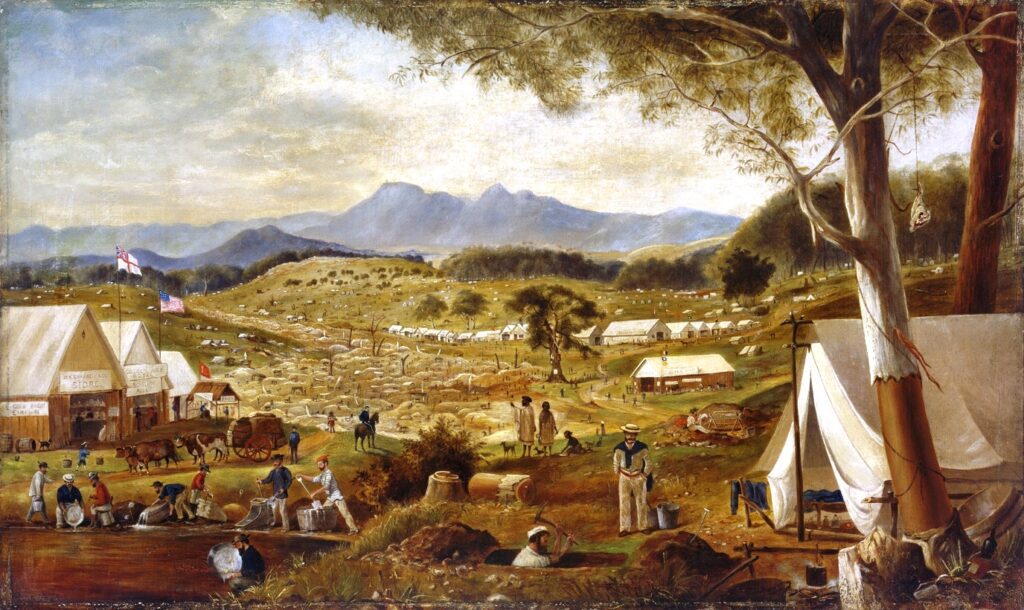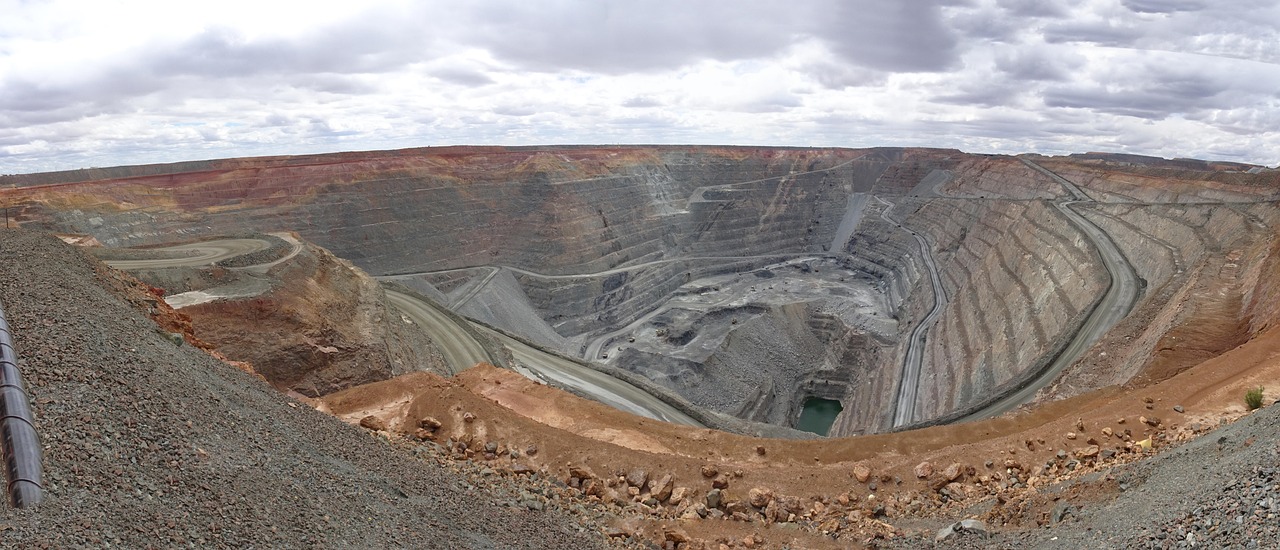The Australian Gold Rushes, especially those in New South Wales and Victoria, attracted prospectors from around the world and significantly contributed to the economic and population growth of the country. They lasted from 1851 to the 1900s.
Contents
Part 1: Introduction
Overview of Australian Gold Rushes
The Australian Gold Rushes were a transformative period in the history of Australia. Beginning in the mid-19th century, these gold rushes brought about rapid development, population growth, and significant changes to the social fabric of the continent. The discovery of gold attracted prospectors from around the world, turning Australia into a destination of hope and opportunity.

Importance and Impact of Gold Rushes
The importance and impact of the gold rushes were far-reaching. They brought immense wealth to Australia, leading to substantial economic growth. The influx of immigrants during this period led to a multicultural society, which is a defining characteristic of modern Australia. Additionally, the Australian gold rushes were a catalyst for societal changes, including the infamous Eureka Stockade rebellion. This event is considered a pivotal moment in the development of Australian democracy and the birth of the Australian identity.
10 Facts of the Australian Gold Rushes
The Australian Gold Rushes were a series of gold discoveries across the country that transformed its economy, demographics, and global standing. Here are some interesting facts about these events:
- First Discovery: The first significant Australian Gold Rush occurred in New South Wales at Ophir Goldfields in 1851.
- Global Migration: The Gold Rushes attracted immigrants from all over the world. From 1851 to 1871 the Australian population more than quadrupled from 430,000 people to 1.7 million mainly because of prospectors arriving from all over the world.
- Victoria Gold Rush: The Victoria Gold Rush lasted from 1851 to the end of the 1860s. During that time this was the area were most of the gold was found – worldwide. For some time, the town of Ballarat was number one in worldwide gold production.
- Multicultural Impact: The Gold Rushes led to a significant increase in Australia’s cultural diversity, with substantial immigration from Europe, North America, and China.
- Eureka Stockade: The Gold Rush era saw a significant civil rights event, the Eureka Rebellion in 1854. This violent public protest by gold miners in Ballarat, Victoria, was against the United Kingdom’s colonial authority and is considered a formative moment in the birth of Australian democracy.
- Impact on Infrastructure: The Gold Rushes led to the expansion of roads, railways, and ports, and increased demand for services, shops, and entertainment, which played a significant role in urbanizing the colonies.
- Birth of Cities: Major cities like Melbourne expanded rapidly due to the Gold Rushes. Numerous smaller towns, like Ballarat and Bendigo, also grew significantly.
- Wealth Creation: The wealth generated from gold helped to fund public works and buildings, boosting the economy and leading to an era of great prosperity in Australia.
- Environmental Impact: The Gold Rushes had significant environmental impacts, such as deforestation, erosion, and introduction of non-native species.
- End of Convict Transportation: The influx of free immigrants during the Gold Rushes, and the associated economic and social changes, led to the cessation of convict transportation to the eastern seaboard of Australia.
Check out other articles about gold rushes on this website:
Main Events of the Australian Gold Rushes
| Year | Event |
| 1851 | Edward Hargraves discovers the first payable gold near Bathurst, New South Wales, sparking the first major gold rush in Australia. |
| 1851 | The Victorian Gold Rush begins with the discovery of gold in various parts of Victoria. |
| 1854 | The Eureka Stockade, a rebellion by miners against the colonial authorities, takes place in Ballarat, Victoria. |
| 1861 | Gold is discovered in Queensland, leading to a new wave of gold rushes. |
| 1869 | The “Welcome Stranger”, the largest alluvial gold nugget ever found, is discovered in Victoria. |
| 1890s | The discovery of gold at Kalgoorlie and Coolgardie in Western Australia leads to the last major gold rush in Australia. |
Part 2: The Beginning of the Gold Rushes
Discovery of Gold in Australia
The discovery of gold in Australia dates back to the early 19th century. However, the first major gold rush didn’t occur until 1851, sparked by Edward Hargraves. After participating in the California Gold Rush, Hargraves returned to Australia, claiming to have found payable gold near Bathurst in New South Wales. This area later became known as the Ophir Goldfield.

The First Gold Rush: Hargraves and the Ophir Goldfield
The first gold rush had a profound impact on Australia. It led to a dramatic increase in population, economic growth, and changes in the social structure. The gold rush also brought challenges, including conflicts between miners and authorities, leading to events such as the Eureka Stockade.
The Victorian Gold Rush and the Impact on Melbourne
The Victorian Gold Rush was another significant event that had a profound impact on Melbourne and the surrounding areas. Gold was discovered in various parts of Victoria, leading to a massive influx of immigrants, particularly from China. This gold rush transformed Melbourne from a small town into one of the wealthiest cities in the world at the time.
During the Victorian Gold Rush, notable events included:
- The discovery of the “Welcome Stranger”, the largest alluvial gold nugget ever found.
- The establishment of the Melbourne Mint in 1872.
- The Chinese immigration to the goldfields, leading to cultural diversity but also racial tensions.
The Victorian Gold Rush ended in the late 1860s, but its impact is still evident today in the architecture and cultural heritage of Melbourne and other parts of Victoria. For more detailed information about the Victorian Gold Rush, visit national museum australia and Wikipedia.
Western Australian Gold Rushes
The Western Australian Gold Rushes in the 1880s marked the last of the major gold rushes in Australia. The discovery of gold in places like Kalgoorlie and Coolgardie attracted prospectors from around the world and led to a significant population increase in Western Australia. The Western Australian Gold Rushes also led to the development of infrastructure and towns in the region, many of which are still active mining towns today.
Part 3: Life During the Gold Rushes

The Journey to the Goldfields
The journey to the goldfields was a significant part of the gold rush experience. Many prospectors traveled long distances, often on foot or by horse-drawn cart, to reach the goldfields. The journey was often difficult and dangerous, with many facing harsh weather conditions, disease, and the risk of attack by bushrangers.
Daily Life and Work in the Goldfields
Life in the goldfields was tough. Prospectors worked long hours in harsh conditions, often with little to show for their efforts. Despite this, the hope of striking it rich kept many going. Daily life involved digging for gold, washing soil and gravel in pans or cradles, and hoping to spot the glint of gold.
Challenges and Hardships
The Australian gold rushes were not without their challenges and hardships. In addition to the physical difficulties of mining, prospectors also faced social and economic challenges. These included high costs for supplies, disputes over mining claims, and the lack of law and order in many mining communities.
Law and Order: The Eureka Stockade
One of the most significant events during the Australian Gold Rushes was the Eureka Stockade. This was a rebellion by miners in Ballarat, Victoria, against the colonial authorities due to grievances over mining licenses and political rights. The rebellion was crushed, but it is seen as a pivotal moment in the development of Australian democracy.
Part 4: The Legacy of the Australian Gold Rushes

Economic Impact and the Wealth of the Goldfields
The gold rushes had a significant economic impact on Australia. The wealth generated from the goldfields helped to fund infrastructure development, such as roads and railways, and contributed to the growth of cities like Melbourne and Sydney. The gold rushes also helped to establish Australia as a significant player in the global economy.
Population Growth and Immigration
The gold rushes led to a significant increase in Australia’s population. Many people from around the world, particularly from China, were attracted to Australia by the prospect of finding gold. This led to a diverse and multicultural society, which is a key aspect of Australia’s national identity today.
Development of Infrastructure and Cities
The wealth generated from the gold rushes also helped to fund the development of infrastructure and cities. Roads and railways were built to transport people and goods, and cities grew rapidly as people flocked to the goldfields. Many of the towns and cities that were established during the gold rushes, such as Ballarat and Bendigo, are still thriving today.
Part 5: Conclusion and Reflection

The End of the Gold Rushes
By the late 19th century, the major gold rushes in Australia had ended. The easy-to-find alluvial gold had been largely exhausted, and mining became more industrialized. However, the legacy of the gold rushes continued to shape Australia in many ways.
Modern Gold Mining in Australia
Today, gold mining is still a significant industry in Australia. Modern mining techniques allow for the extraction of gold from ore that would have been too difficult for the early minersto access. Australia remains one of the world’s largest producers of gold.
Reflection on the Significance of the Australian Gold Rushes
The Australian Gold Rushes were a significant period in the country’s history. They brought wealth and diversity, led to the development of cities and infrastructure, and shaped Australia’s national identity. The legacy of the gold rushes is still evident today in Australia’s vibrant and multicultural society, its thriving cities, and its significant gold mining industry. The spirit of the gold rushes, with their sense of adventure, hope, and opportunity, continues to resonate in the Australian ethos.
Download the article as a PDF: Australian Gold Rushes from 1851 to the 1990s – A Comprehensive Guide (PDF).
FAQs
When did the Australian Gold Rushes start and end?
The Australian Gold Rushes started in 1851 with the discovery of gold near Bathurst, New South Wales by Edward Hargraves. The rushes continued through the mid to late 19th century, with the last major rush occurring in Western Australia in the 1880s. However, the end of the gold rushes does not mean the end of gold mining in Australia. Gold is still mined in many parts of the country today.
Where were the main areas of the Gold Rushes?
The main areas of the Gold Rushes were in New South Wales, Victoria, and later in Western Australia. Notable goldfields included the Ophir Goldfield in New South Wales, Ballarat and Bendigo in Victoria, and Kalgoorlie and Coolgardie in Western Australia.
What were the living conditions like during the Gold Rushes?
Living conditions during the Gold Rushes were often harsh and challenging. Miners lived in makeshift tents and huts, with limited access to clean water and sanitation. They worked long hours in difficult conditions, and the risk of injury or illness was high. Despite these hardships, the hope of striking it rich kept many miners going.
What was the Eureka Stockade?
The Eureka Stockade was a rebellion by gold miners in Ballarat, Victoria in 1854. The miners were protesting against the colonial government's mining licenses and lack of political rights. The rebellion was quickly crushed by the authorities, but it is seen as a pivotal moment in the development of Australian democracy.
How did the Gold Rushes shape Australia?
The Gold Rushes had a profound impact on Australia. They led to significant economic growth, population increase, and social changes. The influx of immigrants during the gold rushes contributed to Australia's multicultural society. The wealth generated from the gold rushes also helped to fund the development of infrastructure and cities.
Are there still active gold mines in Australia today?
Yes, there are still active gold mines in Australia today. Australia is one of the world's largest producers of gold, with major mining operations in Western Australia, New South Wales, and Queensland. Modern mining techniques allow for the extraction of gold from ore that would have been too difficult for the early miners to access.
What happened to the Australian gold rush?
The Australian Gold Rushes gradually came to an end as the easily accessible alluvial gold was exhausted. However, the legacy of the gold rushes continued to shape Australia in many ways, from its economic development to its social structure and national identity. Today, gold mining remains a significant industry in Australia.
What are 5 facts about the Australian gold rush?
1. The first major gold rush in Australia began in 1851 in New South Wales. 2. The largest alluvial gold nugget ever found, the 'Welcome Stranger', was discovered during the Victorian Gold Rush. 3. The Eureka Stockade during the Victorian Gold Rush was a significant event in the development of Australian democracy. 4. The gold rushes led to a significant increase in Australia's population and contributed to its multicultural society. 5. Gold mining is still a significant industry in Australia today, with the country being one of the world's largest gold producers.
How much gold was found in the Australian gold rush?
During this period, hundreds of tonnes of gold were extracted, but exact figures are hard to come by. The largest single piece of gold, the 'Welcome Stranger' nugget, weighed about 72 kilograms.
How much gold is left in Australia?
It's difficult to estimate exactly how much gold is left in Australia as new deposits are still being discovered. However, Australia has some of the world's largest known gold reserves, and it continues to be a major player in the global gold mining industry.
Read about the California Gold Rush from 1849.

